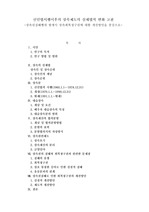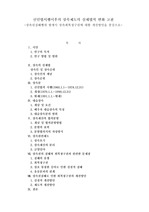

PARTNER
검증된 파트너 제휴사 자료
자식 없이 사망한 배우자의 재산상속 (Inheritance of a married couple who died without a child)
한국학술지에서 제공하는 국내 최고 수준의 학술 데이터베이스를 통해 다양한 논문과 학술지 정보를 만나보세요.
38 페이지
최초등록일 2025.05.21
최종저작일
2018.12

-
미리보기
서지정보
· 발행기관 : 홍익대학교 법학연구소
· 수록지 정보 : 홍익법학 / 19권 / 4호 / 275 ~ 312페이지
· 저자명 : 손경찬
초록
이 연구는 조선시대 자식 없이 사망한 배우자의 재산상속에 관한 연구이다. 조선시대 배우자의 상속은 원칙적으로 부정되었지만, 이 원칙에 대한 예외가 배우자가 자식 없이 사망한 경우였다. 만약 배우자가 자식 없이 사망한 경우 그의 재산은 사망한 배우자의 본족(本族)에게 직접상속이 되었다. 하지만 과부의 생계곤란 등의 문제가 생기자, 국가에서는 생존배우자가 재혼을 하지 않고 살아 있는 동안에는 생존배우자가 사망한 배우자의 재산을 상속하고(先位相續), 생존배우자도 사망한 경우에 그의 재산을 사망한 배우자의 본족에게 귀속하게 하였다(後位相續). 하지만 생존배우자가 재혼을 한 경우에는 복잡한 문제가 발생하였다. 남편이 죽은 뒤 아내가 재혼을 하게 되면 죽은 남편의 재산은 남편의 본족에게 귀속되었다. 반대로 아내가 죽은 뒤에 남편이 재혼한 경우에는 여러 가지 사례가 등장하였다. 그 중 16세기 민사판결인 결송입안(決訟立案)에서 문제가 된 것은 전모(前母) 혹은 계모(繼母)와 의자녀(義子女)가 있는 경우였다. 의자녀와 전모 혹은 계모 사이는 ‘혈족관계’가 아니라 ‘인척관계’일 뿐이므로 원칙적으로 상속이 부정되었다. 다만 조선조에는 의자녀가 사망한 전모 혹은 계모의 제사를 지내는 경우에는 의자녀에게 일정한 비율로 상속재산분할에 참여 할 수 있게 하였다.
따라서 자식 없이 사망한 배우자의 재산 상속문제는 조선시대 상속법제에서 ‘예외 중에서도 예외’적인 사건이다. 원칙적으로 배우자 상속이 부정되는데, 예외적으로 자식 없이 사망한 배우자는 배우자 상속이 허용되었고, 원칙적으로 계모자 관계 및 적모서자 관계에서 상속도 인정되지 않았는데, 예외적으로 이 경우에는 상속이 허용되었다. 따라서 조선 초에는 본족에게 유리하게 상속되다가, 중기 이후에 남계혈족에게 유리하게 법제가 변경되었다는 역사학적 해석론은 타당하지 못하다. 조선시대 상속법제에서 배우자 상속은 부정하는 것이 원칙이었고, 예외적인 사안에서 배우자의 상속을 허용한 것이다. 또한 적모서자 관계의 상속도 원칙적으로 부정되었고, 예외적으로 인정된 것이다. 즉 16세기 결송입안에 등장한 3건의 사례는 조선시대 상속에 관한 수많은 사례 중 하나일 뿐이며, 상속법제에서도 ‘예외 중의 예외’인 사례이다. 이를 보고 상속법제의 종법(宗法)적 변천이라 하는 주장은 타당하지 못한 것이다.영어초록
This study investigated the inheritance of a married couple who died without a child in Joseon Dynasty. Although the inheritance of the spouse was denied in principle in the Joseon Dynasty, the exception was when a spouse died without a child. If a husband or wife dies without a child, his or her property was inherited directly to the family of the deceased spouse. Then the widow’s problem of living occurred. Therefore, the government allowed surviving spouse inherits the property of the deceased spouse while the surviving spouse is alive without remarriage, and after the surviving spouse has also died, the property attributed to the family of deceased spouse. However, when the surviving spouse remarried, complicated problems occurred. If the wife remarried after the husband's death, the property of the dead husband belonged to the husband's family. On the contrary, when the husband remarried after the death of his wife, several examples has emerged. Among them, in a 16th century civil judgment document, a problematic case was about stepmother and stepchild. In this case, inheritance was denied in principle because the stepmother and the stepchild are not ‘blood relatives’ but ‘relatives’. However, in the Joseon Dynasty, when the stepchild completed ancestral rites for the stepmother after she died, the stepchild could inherit her property at a certain rate.
Thus, the issue of inheritance of a married couple who died without a child is a rare exception in the inheritance law of the Joseon era. As a rule, spousal inheritance was denied except for a spouse who have died without a child. Furthermore, in principle, the inheritance was not allowed in the relationship of stepfamily, it was applied exceptionally to the stepmother and stepchild relationship. Therefore, it is not a reasonable historical interpretation that the inheritance was beneficially inherited to the family in the early Joseon period, and the legal system was changed in favor of male relatives after the middle Joseon period. Throughout the Joseon Dynasty, the principle of denying spousal inheritance existed in inheritance law, and inheritance by spouses was only allowed in exceptional cases. Also, inheritance between the stepmother and the stepchild was denied in principle and only exceptional cases were allowed. In other words, the three cases in the 16th century civil judgment document were only a few of many examples of inheritance in the Joseon Dynasty and rare exceptional cases in the inheritance law. Therefore, the claim that the law of inheritance has undergone a legal transition from these examples is not reasonable.참고자료
· 없음태그
- # 자식 없이 사망한 남편과 아내(無子息亡夫妻)
- # 재산상속
- # 선위상속(先位相續)
- # 후위상속(後位相續)
- # 결송입안(決訟立案)
- # 계모자 관계 혹은 적모서자관계의 재산상속
- # married couple who died without a child
- # Inheritance of property
- # inheritance to the surviving spouse(先位相續)
- # inheritance to the family(後位相續)
- # civil judgment document(決訟立案)
- # inheritance between stepmother and stepchild
-
자주묻는질문의 답변을 확인해 주세요

꼭 알아주세요
-
자료의 정보 및 내용의 진실성에 대하여 해피캠퍼스는 보증하지 않으며, 해당 정보 및 게시물 저작권과 기타 법적 책임은 자료 등록자에게 있습니다.
자료 및 게시물 내용의 불법적 이용, 무단 전재∙배포는 금지되어 있습니다.
저작권침해, 명예훼손 등 분쟁 요소 발견 시 고객센터의 저작권침해 신고센터를 이용해 주시기 바랍니다. -
해피캠퍼스는 구매자와 판매자 모두가 만족하는 서비스가 되도록 노력하고 있으며, 아래의 4가지 자료환불 조건을 꼭 확인해주시기 바랍니다.
파일오류 중복자료 저작권 없음 설명과 실제 내용 불일치 파일의 다운로드가 제대로 되지 않거나 파일형식에 맞는 프로그램으로 정상 작동하지 않는 경우 다른 자료와 70% 이상 내용이 일치하는 경우 (중복임을 확인할 수 있는 근거 필요함) 인터넷의 다른 사이트, 연구기관, 학교, 서적 등의 자료를 도용한 경우 자료의 설명과 실제 자료의 내용이 일치하지 않는 경우
“홍익법학”의 다른 논문도 확인해 보세요!
-
교통 플랫폼 구축 ‧ 운영을 위한 법제 현황과 과제 34 페이지
정보기술의 발전으로 교통이 혁신적인 변화를 맞고 있다. 사람과 사물의 모빌리티 데이터는 인공지능 기술에 기반하여 수집․가공되고 제3자에 제공되어 이용되면서 기존의 교통기술을 지능화시키고 새로운 부가가치를 창출하고 있다. 이 글은 교통 플랫폼의 구축과 운영을 규율하는 법령 현황과 그 문제점을 살펴보고 개선 방안을 제시하는 것을 목적으로 한다. 이러한 목적을 .. -
징벌적 손해배상제도에 관한 국내 입법의 현황과 문제점 29 페이지
기업의 고의적 불법행위나 불공정거래가 만연해지면서 징벌배상제도는 국민들의 규범적 지지를 받고, 여러 특별법으로 그 영역을 확장하고 있다. 이제는 제도 도입 여부에 관한 논쟁을 뛰어 넘어, 현행 입법형식은 타당한지, 손해배상법과 체계적 정합성을 갖추기 위한 방법은 무엇인지, 일반화된 3배 배상의 근거는 적정한지에 대한 보다 구체적이고 진전된 논의가 필요한 때.. -
한국 대체복무제의 입법론 36 페이지
헌법재판소의 결정에 따라 대체복무제의 도입을 위한 입법절차가 진행되고 있다. 지금까지 헌법해석론 차원에서 치열하게 논의되었던 병역거부권 인정 문제가 대체복무제의 입법론 문제로 옮겨지게 된 것이다. 이제 국회는 헌법재판소 결정의 취지를 존중하는 동시에 그 논거를 비판적으로 검토하면서 자신의 입법형성권을 행사하여 신념적 병역거부자를 위한 대체복무제를 입법하여야.. -
지방계약과 지방자치- 지방계약의 자치보장적 함의에 관하여 - 47 페이지
본고는 행정계약과 지방자치의 관계가 어떠한 관계에 있는지 분석하는 것을 목적으로 한다. 이를 위하여 다음과 같은 문제들을 단계적으로 검토한다. 첫째, 지방계약법이 지방재정법에서 분리된 이유가 무엇인가. 둘째, 지방계약법을 국가계약법과 구별하는 이유는 무엇인가. 셋째, 지방계약법을 조달사업법과 연계하는 이유는 무엇인가. 넷째, 지방계약이 지방자치법에 미치는 .. -
「노인복지법」상 노인학대 신고제도와 그 개정안 32 페이지
노인학대가 심각해지면서 정부에서는 2004년 1월 29일 「노인복지법」 개정을 통해 노인학대 관련 규정을 처음 신설하면서 노인학대 신고를 활성화기 위해 노인학대 신고의무자의 설정을 비롯하여 학대 신고절차에 관한 규정(제39조의6)을 도입하였다. 노인학대는 대부분이 가정 내에서 발생하기 때문에 피해노인이 가족 내부의 문제가 외부로 알려지는 것을 꺼려서 발견되..
찾으시던 자료가 아닌가요?
지금 보는 자료와 연관되어 있어요!
문서 초안을 생성해주는 EasyAI



